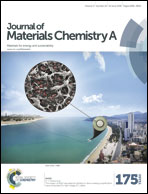Self-assembled tri-, tetra- and penta-ethylene glycols as easy, expedited and universal interfacial cathode-modifiers for inverted polymer solar cells†
Abstract
Non-conjugated triethylene glycol (3-EG), tetraethylene glycol (4-EG) and pentaethylene glycol (5-EG) are presented as new cathode modification materials to achieve high-performance inverted-PCSs. By spin-coating from a non-chlorinated solvent, these small molecules can self-assemble on ITO via surface coordination and hydrogen bonding to form an ultra-thin layer. Theoretical simulations reveal that the coordination of oxygen atoms in the EG molecules to indium moieties on the ITO surface is the major mechanism in inducing interfacial dipoles, thereby reducing the work function (WF) of ITO for efficient electron collection. Based on the PBDTTT-EFT:PC71BM blend, the bulk heterojunction device using the 5-EG layer exhibited a higher short-circuit current density (Jsc) of 15.27 mA cm−2, fill factor (FF) of 0.69, and power conversion efficiency (PCE) of 8.46%, which are better than those of the corresponding devices using either inorganic ZnO or non-conjugated poly(ethylene oxide) (PEO) as the cathode buffer layer. More importantly, this simple and expedited strategy is also demonstrated to be universally applicable to various p-type conjugated polymers. The EG oligomers with well-defined chemical structures have the advantages of easy availability, simple processability and good device reproducibility, which are crucial keys for future commercialization using large-scale roll-to-roll production.


 Please wait while we load your content...
Please wait while we load your content...